1840, U.S. Census: total population, 17.07 million; slaves, 2.49 million (14.6% of total); free black, 386,000 (2.3%).
While the number of slaves increased 24% over the decade, the number of immigrants more than quadrupled to 599,000, (including 207,000 Irish and 152,000 Germans).
1840, William Henry Harrison (Ohio) elected president, defeating Van Buren. Harrison dies one month into his term, April 4, 1841, and John Tyler (Virginia) becomes president. New Whig party brings together many anti-Jackson, anti-Democratic party elements and personalities, including abolitionists, Anti-Masons. Leaders include Daniel Webster, Henry Clay, William Seward and John Quincy Adams.
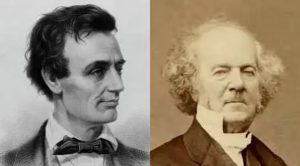 Garrison and Lewis Tappan.
Garrison and Lewis Tappan.
1840, American Anti-Slavery Society convention splits between Garrison majority and Tappan brothers who advocate political action and a less militant stance, and oppose demands for women’s rights, May 12.
Garrison’s position is that the Constitution is pro-slavery and can’t be fixed, thus free states must secede (by means of spiritual strength, not war). He also favors greater recognition for women, who already play major roles in group’s activities. Garrison prevails at the convention.
Tappans leave to create, first, the American and Foreign Anti-Slavery Society, and then the Liberal Party, the nation’s first abolitionist political party. The Liberal candidate for president, James G. Birney, a former slave master from Kentucky, wins only 7,000 votes against Harrison and Van Buren.
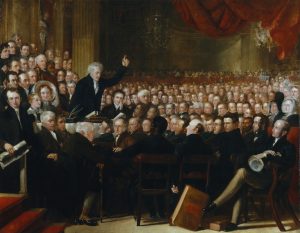 Clarkson rises in London.
Clarkson rises in London.
1840, Thomas Clarkson opens first World Anti-Slavery Convention in London. Ireland’s Daniel O’Connell is a leading speaker in drive to unite abolitionists worldwide, with U.S. slavery a particular target, June 12. Quakers from Britain and the U.S. play a large role.
William Lloyd Garrison leads U.S. contingent, including Lucretia Mott and Elizabeth Cady Stanton, but women are not allowed to participate. This inspires Mott and Stanton to begin organizing what will become the Seneca Falls Convention for women’s rights in 1848.
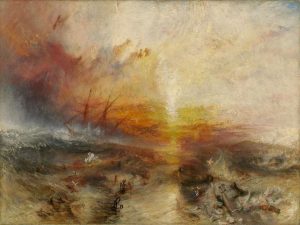 The Slave Ship.
The Slave Ship.
1840, J.M.W. Turner’s dramatic painting memorializing 1781 Zong incident goes on display at the Royal Academy in London.
Showing is timed to coincide with the Anti-Slavery Convention led by Clarkson.
1840, William Henry Harrison (Ohio) elected president, defeating Van Buren. Harrison dies one month into his term, April 4, 1841, and John Tyler (Virginia) becomes president.
New Whig party brings together many anti-Jackson, anti-Democratic party elements and personalities, including abolitionists, Anti-Masons.
Leaders include Daniel Webster, Henry Clay, William Seward and John Quincy Adams. But Harrison will be sole Whig elected to presidency.
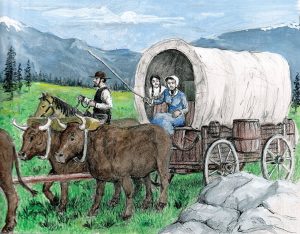
1840, First wagon trains with American settlers travel Oregon Trail to the Willamette Valley. In 1846, the Oregon Treaty with Britain extends 49th parallel from Rockies to Strait of Georgia as U.S.-Canada border.
1840, Large Comanche war party crosses central Texas (still a republic) to an inlet of Matagorda Bay on the Gulf of Mexico where they loot and burn the port of Linnville, Aug. 7. Most citizens escape on boats.
This largest Indian raid ever on a white city in present-day U.S. is in retaliation for the earlier killing of 33 Comanche leaders at a peace negotiation in San Antonio. Comanche-Texas fighting continues into 1844.
1840, Britain wins treaty with Republic of Texas for mutual suppression of the slave trade, Nov. 16, in return for British recognition of Texan sovereignty. Lord Palmerston signs for Britain.
1840, Royal Navy bases ships at Saint Helena in South Atlantic to stop slave ships bound from Angola and Mozambique to Brazil and West Indies.
As many as 26,000 slaves are freed from ships brought here over next 32 years. An estimated 5,000 arrive dead or dying, and they are buried in island’s Rupert’s Valley. More than 80% are children, teenagers or young adults.
Most of the freed people who survive are sent to Cape Town and the British West Indies as laborers.
Also on Saint Helena, Napoléon’s body is exhumed, Oct. 15, and sent to France to be placed in Les Invalides, Paris.
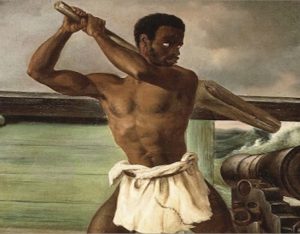 Washington leads attack.
Washington leads attack.
1841, Slaves being transported from Virginia to New Orleans take over Creole and direct her to slavery-free Bahamas. British free more than 110 immediately; 17 others, including leader Madison Washington, who took part in killing of a slave trader and wounding of several crew, are held.
Nassau court rules their action is not piracy but rightful. Southerners enraged by British actions; eventually slave masters receive some compensation.
Frederick Douglass fictionalizes the incident in a novella, The Heroic Slave, published in 1853.
1841, Nicholas Trist is dismissed as U.S. consul in Havana amid allegations that he connived at, or made little effort to suppress, illegal sale of U.S. vessels to Spanish slave traders.
1841, Quintuple Treaty signed, under which Britain, France, Russia, Prussia and Austria agree to the search of their vessels on the high seas by any of the signatory navies to suppress slave trade.
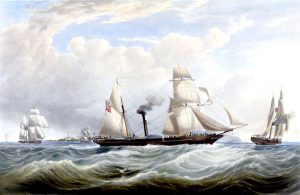
1841, Niger Expedition, organized by British “New Africa” movement which seeks to end slave trade and extend Christianity, sets out in three ships for Lokoja (in present-day Nigeria), where Benue river meets the Niger.
The expedition, supported by Prince Albert, hopes to develop alternative trade opportunities that would encourage African kingdoms to end their role in the slave trade.
Once there, disease quickly kills more than 50 of the 150 Europeans and sickens still more, December. Expedition retreats to Fernando Po (now Bioko Island) to return to Britain the following year.
1842, In Prigg vs. Pennsylvania, U.S. Supreme Court strikes down state’s personal liberty law of 1826 (copied by other Northern states) to uphold 1793 federal fugitive slave law. But Justice Story’s opinion permits Northern states to deny use of their facilities for purpose of returning fugitives.
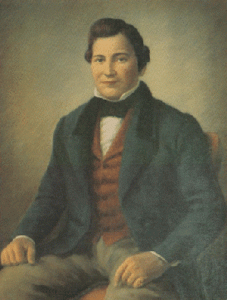 Joseph Vann.
Joseph Vann.
1842, In Indian Territory (Oklahoma), 20 black slaves escape Cherokee plantations of “Rich Joe” Vann, Nov. 15. They raid Webbers Falls (Arkansas river) for supplies and guns, set out for Mexico and kill two bounty hunters to free a slave family.
Large Cherokee posse runs them down just north of the Red river. All taken back; five executed, remainder put to work on Vann’s steamboats.
Cherokee nation passes a stricter slave code and requires expulsion of freed blacks. Escape attempts continue.
Two years later: The steamboat Lucy Walker suffers a catastrophic boiler explosion and sinks after departing Louisville, Oct 23. “Rich Joe,” captain and owner, dies, as do most of his enslaved crew and 36 of perhaps 85 passengers.
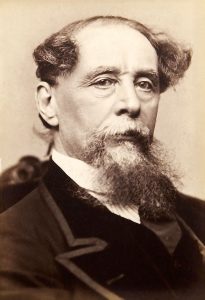 Charles Dickens.
Charles Dickens.
1842, Charles Dickens, age 30, and between The Old Curiosity Shop and A Christmas Carol, tours American cities over five months, giving readings, visiting prisons and hospitals, meeting statesmen and writers.
In March, he visits a Richmond chewing-tobacco factory worked by slaves.
Always an advocate for the poor, Dickens excoriates the U.S. acceptance of slavery near the conclusion of American Notes for General Circulation, published after his return to England.
1842, In Webster-Ashburton Treaty, U.S. agrees to Royal Navy searches of American vessels (and vice-versa) to suppress slave trade.
Treaty is mainly written to resolve U.S.-Canada border issues in the Oregon Country, between Maine and New Brunswick, and on the Great Lakes.
U.S. also declines to insist on return of estimated 12,000 fugitive slaves in Canada.
1842, Slavery ends in Uruguay, with competing Colorado and Blanco parties both promising emancipation. But a quasi-free patronato system continues to 1853.
1842, Earthquake estimated at 8.1 Ms destroys Cap Haïtien, killing at least 5,000, May 7. Resulting tsunami kills at least 300 in Port-de-Paix alone.
Chaos leads to rural uprising that unseats progressive Pres. Jean-Pierre Boyer, in February, and aids Dominican forces seeking to end Haitian rule of their side of the island.
1840, Sporadic fighting continues, but most Seminole, perhaps 4,000—including 500 Black Seminoles descended from escaped slaves who are considered free—agree, between 1838 and 1843, to board ships for New Orleans on their way to Indian Territory.
High cost to U.S.: Commanders included Winfield Scott and Zachary Taylor. As many as 2,000 soldiers and militia dead (many from disease) out of 40,000 committed; at least $40 million spent, including payments to Seminole leaders.
Several Seminole bands remain in Everglades, and a Third Seminole War breaks out in 1856.
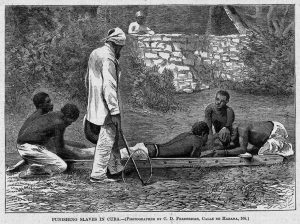 Lashing rebel to ladder.
Lashing rebel to ladder.
1843, Cuban slave conspiracy that may or may not have ignited actual insurrection on Matanzas plantations, is reputedly led by African-born Yorubans, including Carlota Lucumí, November. Details are vague, but whites have been living with increasing fear as slave population has soared and smaller revolts have broken out.
Gov. Leopoldo O’Donnell orders suspected leaders executed by firing squad in Havana, early 1844. Thousands are imprisoned or banished. David Turnbull, the British consul (and abolitionist), expelled in 1842, is convicted of incitement in absentia.
Known as the “Year of the Lash” and “Conspiración de la Escalera,” as suspected rebels are lashed to ladders for interrogation. White Cubans opposed to Spanish rule are inspired to consider enlisting slaves as allies, which will come to pass in 1868.
1844, Texas recognizes Comanche possession of the Comanchería (most of West Texas and eastern New Mexico) in return for end to raids. This is a high point in the history of the Plains tribe most successful in maintaining its lands and independence from white settlers.
But between European diseases (which they had avoided for decades) and post-Civil War slaughter of buffalo, 90 percent of Comanche population is lost by 1874.
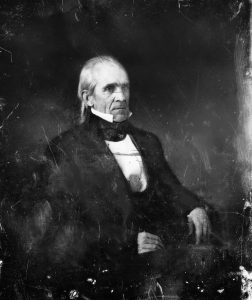 James Polk.
James Polk.
1844, Annexation of Texas (sought by pro-slavery forces) is favored by Democrat James K. Polk (Tennessee) in his close election to presidency. He defeats Whig Henry Clay (who still owns slaves but waffles on annexation) and Liberal James G. Birney (former slaveholder turned abolitionist who opposes annexation). Birney’s vote share in New York and Michigan probably costs Clay the election.
1844, Oregon Country’s provisional government outlaws slavery but immediately seeks to expel free blacks, even threatening “the lash” if they don’t leave.
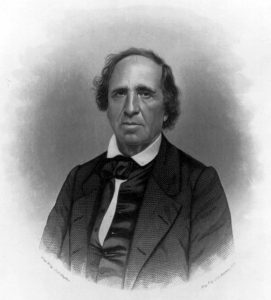 James Osgood Andrew.
James Osgood Andrew.
1844, Methodist Episcopal Church divides over censure of Bishop James O. Andrew who has gained a second slave with his marriage. Methodists generally have been opposed to slavery since forming their U.S. church in 1784. But in South, more ministers accept it, if slaves are treated well; they now form Methodist Episcopal Church, South.
1844, Dominican rebels end 22 years of Haitian rule of Santo Domingo side of island, establishing First Republic of Dominican Republic. Subsequent Haitian invasions are turned back over the next 15 years.
1845, Florida joins Union and independent Texas is annexed, becoming the 14th and 15th slave states, compared to 13 free. But they are the last slave states.
1845, Baptist Church splits over slavery. Southern ministers say that while it may be “a great evil,” slavery is not a sin, and now defend it as a “Bible-endorsed” institution.
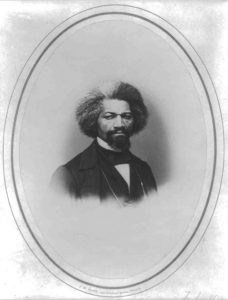 Original book cover.
Original book cover.
1845, Narrative of the Life of Frederick Douglass, an American Slave, written by himself, is published.
1845, Frustrated by Brazil’s failure to enforce its 1830 slave-trade ban, Britain’s Parliament passes Aberdeen Act, giving Royal Navy authority to seize Brazilian slave ships, with cases adjudicated in its admiralty courts, not by ineffective Mixed Commissions.
In response, Brazilian slavers rush to buy and ship as many African slaves as possible before the naval crackdown takes hold; the numbers surge between 1847 and 1849.
In first six months of 1848, 19 of 33 suspected slave-ship cases at St. Helena vice-admiralty court are Brazilian.
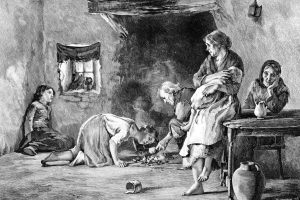 Famine devastates Ireland.
Famine devastates Ireland.
1845, Potato blight sweeps Europe with Ireland suffering its Great Famine. Over the next five years, one million Irish die of starvation and disease, especially typhus. British government’s laissez-faire policies, absentee landlords and impoverishment of tenant farmers blamed.
Misery peaks in 1847 with mass evictions of poor tenant farmers by landlords; western and southern counties suffer the most.
More than 2 million people, mostly young, emigrate by 1855, a majority to the U.S. and Canada.
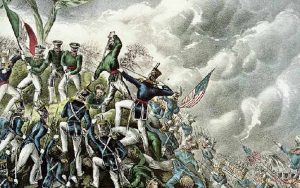 Polk's army fights Mexicans for land.
Polk's army fights Mexicans for land.
1846, Pres. Polk sends more ships to navy’s Pacific squadron and orders army under Zachary Taylor south of Texas’s Neuces river, which Mexico considers the border. Rio Grande skirmishes provide sparks and Congress declares war, May.
Navy forces quickly take Monterey, Yerba Buena (San Francisco) and Sacramento in California, with little or no fighting. Conquest of Alte California completed in January 1847 after small battles near Los Angeles (Stockton, Frémont, Kearney lead at various locations).
Note: Divided on the war are Congressmen Abraham Lincoln of Illinois, who opposes it as a ploy to add slave states, and Jefferson Davis of Mississippi, who raises and commands a regiment, and returns with a wound to the foot.
1846, Iowa joins Union as 14th free state, compared to 15 slave.
1846, American Missionary Association is created by Congregationalist churches in Albany, NY, Sept. 3, with abolitionist leaders of both races, to found anti-slavery churches, and to promote racial equality and education of black people.
The association is active during the Civil War in educating newly freed slaves, and during Reconstruction in founding permanent colleges, most of them in the South, for teachers and other professions.
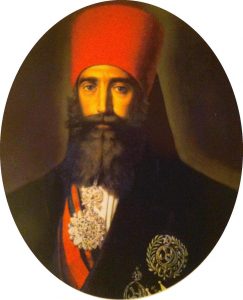
Ahmad I ibn Mustafa.
1846, Tunisia becomes the first Muslim state to abolish slavery, by decree of Ahmad I ibn Mustafa, a reforming bey, whose mother is reported to have been a slave. Ahmad is noted for having one wife and one concubine only.
Abolition takes effect mainly in the cities, where ex-slaves form an underclass, and is resisted elsewhere. Complete abolition, decreed in 1890, is enforced by the French occupation that began in 1881.
1847, Misery peaks as British attempts to deal with famine in Ireland fall short. With government support, perhaps 200,000 men, women and children depart from Queenstown, Galway and mainly Liverpool on overcrowded, unhealthy ships bound largely for Canada. More than 17,000 will die on the 6- to 10-week journey, many of typhus spread by lice, or soon thereafter on Grosse Island and other St. Lawrence river quarantine facilities or on board scores of ships waiting their turn to unload the sick.
As many as half the “Black 47” ship survivors make their way into a U.S. that is far from welcoming to Catholics. The poorest refugees never get farther than Liverpool (or Glasgow), only to be shunned and (most) ultimately deported back to Ireland where the potato blight only worsened in the following year.
1847, Meanwhile, “Caste War” breaks out, July, on the Yucatán peninsula between Yucatecos (white descendants of Spanish families) who want to expand sugar-cane and agave holdings, and native Mayans (75% of population) who fight to preserve communal lands and to avoid high taxes.
Mayans achieve autonomous state of Chan Santa Cruz (present Quintana Roo) amid decades of fighting, but tide turns and Mexican, Guatemalan and British Honduran forces prevail by 1901; final peace declared only in 1915. Deaths total at least 40,000.
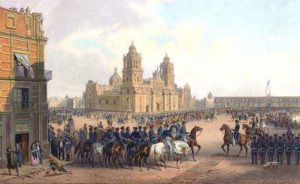
1847, In Mexico, Americans win at Monterrey and Buena Vista (Taylor), at Vera Cruz, despite yellow fever (Scott and Perry) and at Chapultepec, and occupy Mexico City (Scott) in September. An efficient war, but divisive politically.
1847, Stephen Foster’s early minstrel song is performed at Andrew’s Eagle Ice Cream Saloon, Pittsburgh, Sept. 11. A huge sheet-music hit, it boosts Foster’s song-writing career and is soon followed by “Louisiana Belle,” “Campton Races,” and “Ring, Ring de Banjo,” all written for blackface minstrel groups, including the Christy Minstrels.
Foster later turns to “parlor songs” like “Jeannie with the Light Brown Hair” and “Beautiful Dreamer,” the latter published after his 1864 death in New York at age 37.
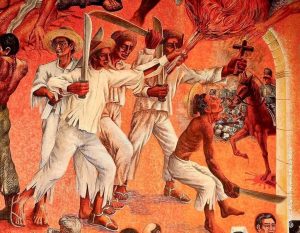 Yucatecos and Mayans fight in Caste War.
Yucatecos and Mayans fight in Caste War.
1847, Meanwhile, “Caste War” breaks out on the Yucatán peninsula between Yucatecos (white descendants of Spanish families) who want to expand sugar-cane and agave holdings, and native Mayans (75% of population) who fight to preserve communal lands and to avoid high taxes, July.
Mayans achieve autonomous state of Chan Santa Cruz (present Quintana Roo) amid decades of fighting, but tide turns and Mexican, Guatemalan and British Honduran forces prevail by 1901; final peace declared only in 1915. Deaths total at least 40,000.
1847, Liberia declares its independence from the American Colonization Society. John Roberts, a free man of color born in Norfolk, VA (whose mother was freed before he was born), is sworn in as the first president.
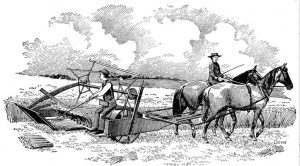
McCormick reaper in action.
1847, In Chicago, Cyrus McCormick begins factory production of mechanical reaper (patent issued to him in 1834), which will vastly increase agricultural production on the Plains and worldwide.
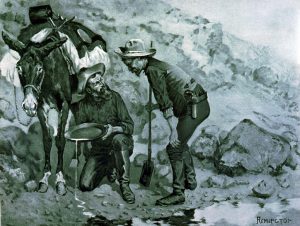 Miners descend on California.
Miners descend on California.
1848, California gold rush set in motion with discovery near Sutter’s Mill, northeast of Sacramento, Jan. 24. A San Francisco paper breaks news in March. New York Herald announces it to East Coast, August. In 1849, 90,000 are drawn to difficult-to-reach California.
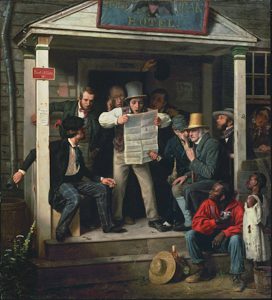 Huge expansion of U.S.
Huge expansion of U.S.
1848, Mexico signs Treaty of Guadalupe Hidalgo, February. Establishes Rio Grande as U.S. border, and cedes California and nearly all territory in today’s Texas, New Mexico, Arizona, Nevada, Utah and western Colorado. Mexico gets $15 million and pledge that Mexicans who stay will retain their lands and receive U.S. citizenship.
California: 1847 population estimated at 6,500 Californios (of Mexican or Spanish descent), 700 foreigners (mostly American) and 150,000 Indians.
By 1855, total non-Indian population is 300,000 from around the world.
1848, Wisconsin joins Union as 15th free state, tying the count with the 15 slave states.
Northern Democrats push the Wilmot Proviso, which would outlaw slavery in all lands gained from Mexico. It passes House for the third time, but again fails in Southern-dominated Senate.
But it keeps the debate alive on status of slavery in new territories.
1848, More than 75 slaves, aided by free blacks and abolitionists, attempt escape from Washington, DC, on the schooner Pearl. Caught off Point Lookout, they are returned to an angry pro-slavery mob.
Most are sold to traders who transport them to New Orleans markets. Two teenage sisters, Mary and Eliza Edmonson, are freed with funds raised by the Brooklyn congregation of Henry Ward Beecher.
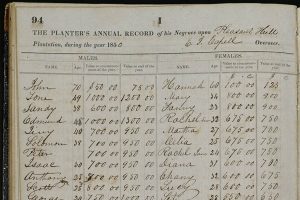 Account book lists slaves.
Account book lists slaves.
1848, Cotton Plantation Record and Account Book, a veritable fill-the-blanks spreadsheet for managing plantations, and for measuring production and value of each slave, is published by Thomas Affleck. He is a Scottish immigrant and trained agrarian who owns a plantation in Washington, MS. New editions, which sell in the hundreds, published annually through 1860.
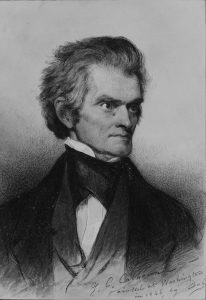 John C. Calhoun.
John C. Calhoun.
1848, John C. Calhoun rallies Southern senators and representatives in Senate chamber with speech advocating slavery as a state right, and asserting that forced emancipation of slaves would be an act of aggression.
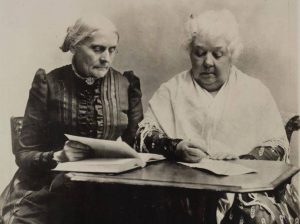 Lucretia Mott, Elizabeth Cady Stanton.
Lucretia Mott, Elizabeth Cady Stanton.
1848, First Women’s Rights Convention, organized in Seneca Falls, NY, by Elizabeth Cady Stanton; Lucretia Mott and her sister, Martha; Mary M’Clintock; and Jane Hunt. All are active abolitionists; all except Stanton are Quakers, July.
More than 300 attend. Frederick Douglass helps win convention approval of the demand for the vote.
1848, Zachary Taylor (Louisiana), made popular by the Mexican War, elected over Democrat Lewis Cass (Michigan) and Van Buren (New York), who leaves Democrats to lead anti-slavery Free Soil Party (which included Liberty Party).
While parties hold conflicting positions on slavery, they avoid it as a campaign issue. Van Buren’s splitting of Democratic vote in New York results in election of Taylor who is second and last president elected on the Whig line. Millard Fillmore (New York) elected vice president.
1848, Revolution by liberals, working-class radicals, reformers and nationalists sweeps Europe, beginning in France (February), and running through smaller German states, Hungary, Italian states, Poland, etc.
Demands are for universal male suffrage, freedom of the press. Opponents blame it, in part, on European potato blight that has killed many thousands, on the Panic of 1847 and on resulting economic distress.
French overthrow monarchy again, and create Second Republic headed by Louis-Napolean who stages a coup, 1852, and establishes himself as emperor of the Second Empire.
After tremendous initial success in other countries, the new liberal regimes are almost universally overthrown. Leaders are executed or imprisoned, and many followers flee to Americas. But progressive forces are set in motion.
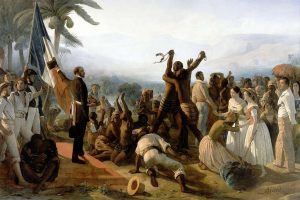 Celebrating freedom.
Celebrating freedom.
1848, New Second French Republic votes to permanently abolish slavery in all colonies within the year, April 27. Slave uprising on Martinique (65 slaves and 34 settlers die) leads to immediate abolition on that island, May 22. Guadeloupe quickly follows, May 27. Guiana’s slaves are freed Aug. 10.
Victor Schoelcher, a staunch abolitionist familiar with the colonies, leads the effort. The following year, legislation passes granting former owners a total of 120 million francs in compensation.
1848, Danish King Christian VIII supports gradual abolition on St. Thomas, St. John and St. Croix, scheduled for 1859. But slaves, led by “General” Buddhoe rise on St. Croix, July 2, burning plantations and besieging Frederiksted. Governor-general takes it upon himself to declare them immediately emancipated and wins cooperation toward negotiating new, free system.
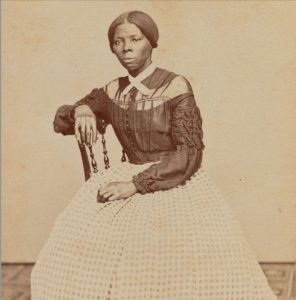 Harriet Tubman.
Harriet Tubman.
1849, Harriet Tubman (born Araminta Ross) escapes Madison, MD, slave master to Philadelphia; soon returns for her family to begin 10-year career of helping to free slaves. She guides more than 70 men, women and children to freedom via the Underground Railroad and sets them up in Northern states and in Canada.
Also, Henry “Box” Brown ships himself in a crate from slavery in Richmond to Philadelphia.
1849, California delegates elected in August (at direction of U.S. military governor) convene in Monterey to write first constitution, a year before statehood.
1849, Royal Navy squadron, led by Capt. Peter Fitzgerald, destroys the Lomboko slave factory at mouth of Gallinas river, Sierra Leone. Spanish slave merchants, led by Pedro Blanco, were illegally exporting 2,000 slaves a year, including the Amistad captives; Fitzgerald had testified at their 1840 trial in New Haven.
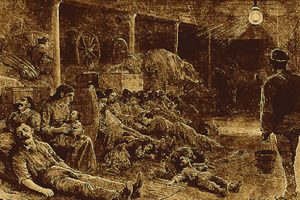 Disease and death again.
Disease and death again.
1849-1855, A third worldwide cholera pandemic that killed a million Russians and 52,000 in England in 1848, travels to famine-weakened Ireland in 1849 and again crosses the Atlantic.
New York avoids the worst, but the Mississippi Valley suffers (4,500 die in St. Louis, 3,000 in New Orleans). Former Pres. James K. Polk dies of cholera June 1, 1849 in Nashville, TN, after a riverboat journey from New Orleans.
Disease sweeps into Mexico and the Caribbean. Jamaica hit in 1851, followed by Puerto Rico and, lastly, the Bahamas and Windward Islands. At least 200,000 die across the Caribbean, 40,000 on Jamaica alone, 10% of the population.
Santo Domingo reports many deaths but its neighbor, Haiti, escapes unscathed. Why? Independent Haiti receives few immigrants, no slaves and no colonial troops (major spreaders elsewhere).
